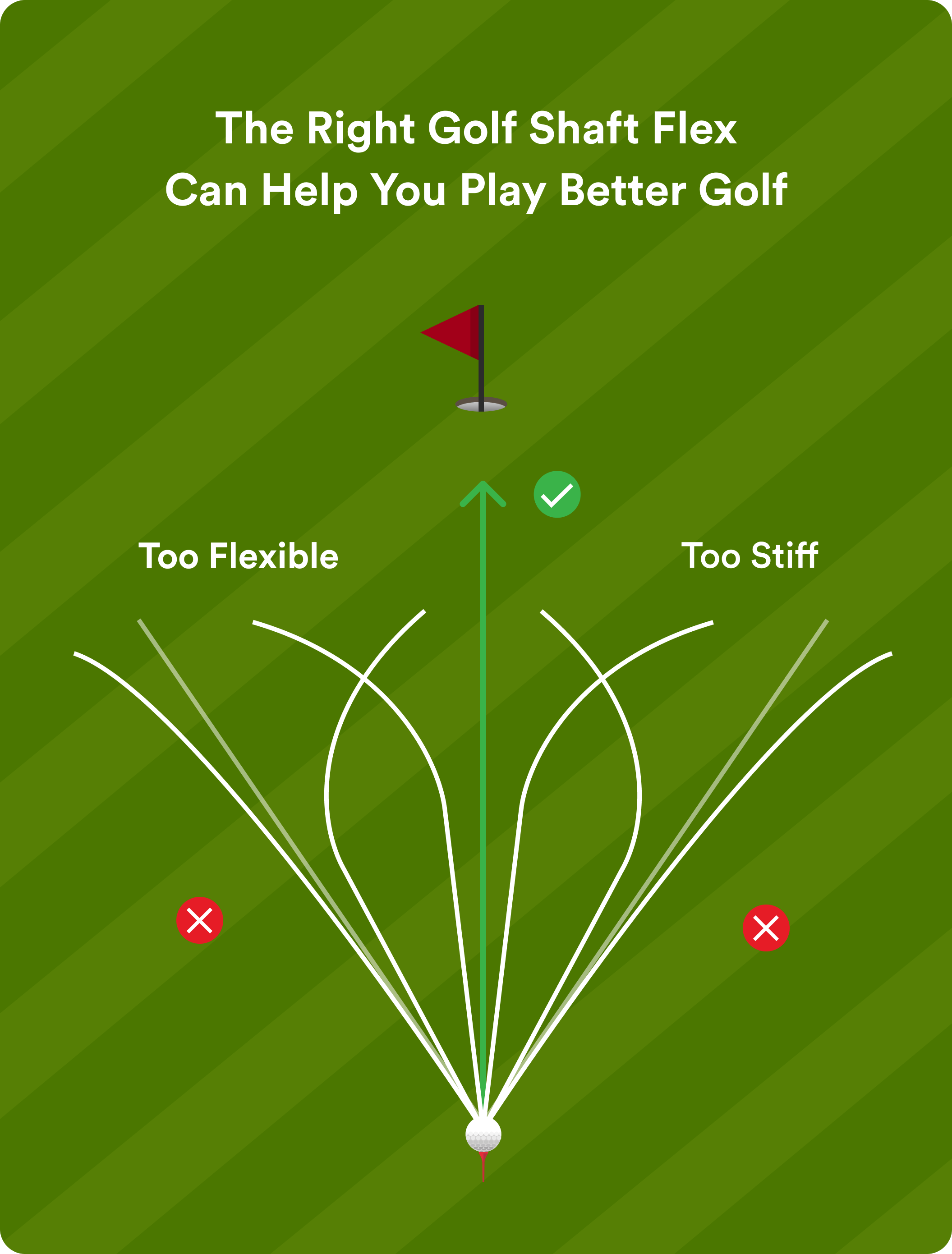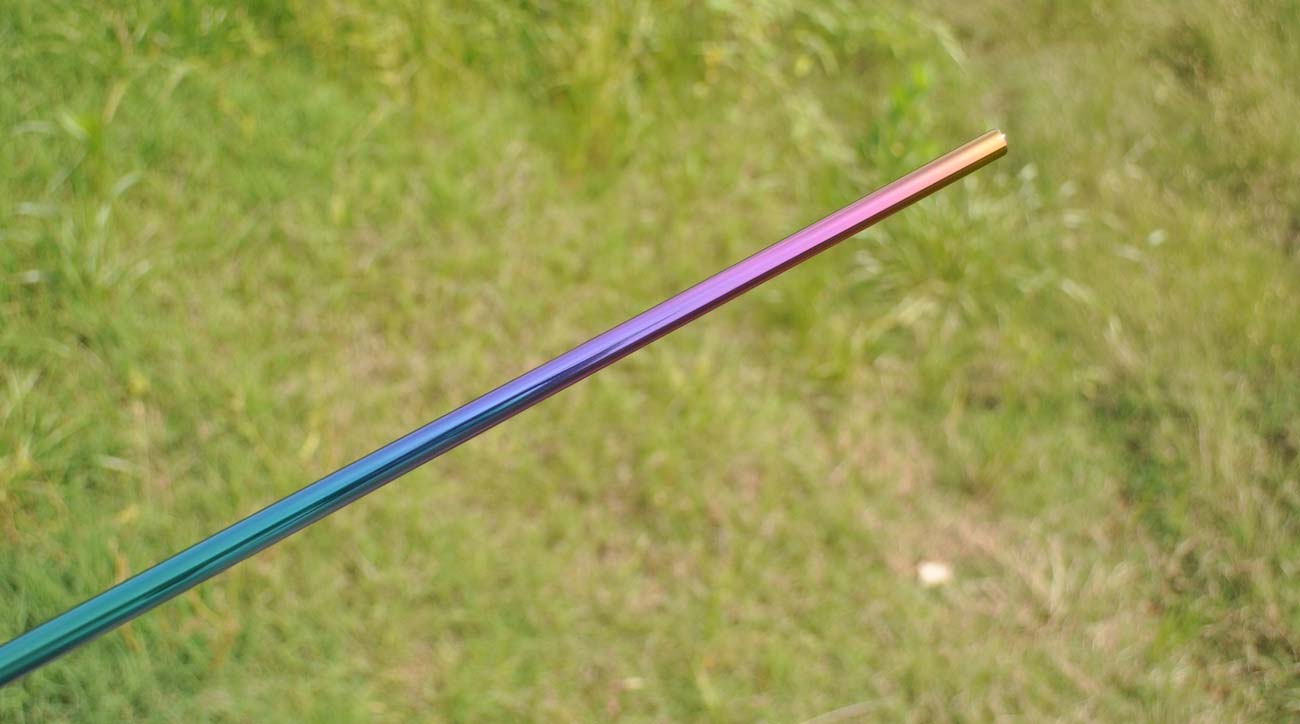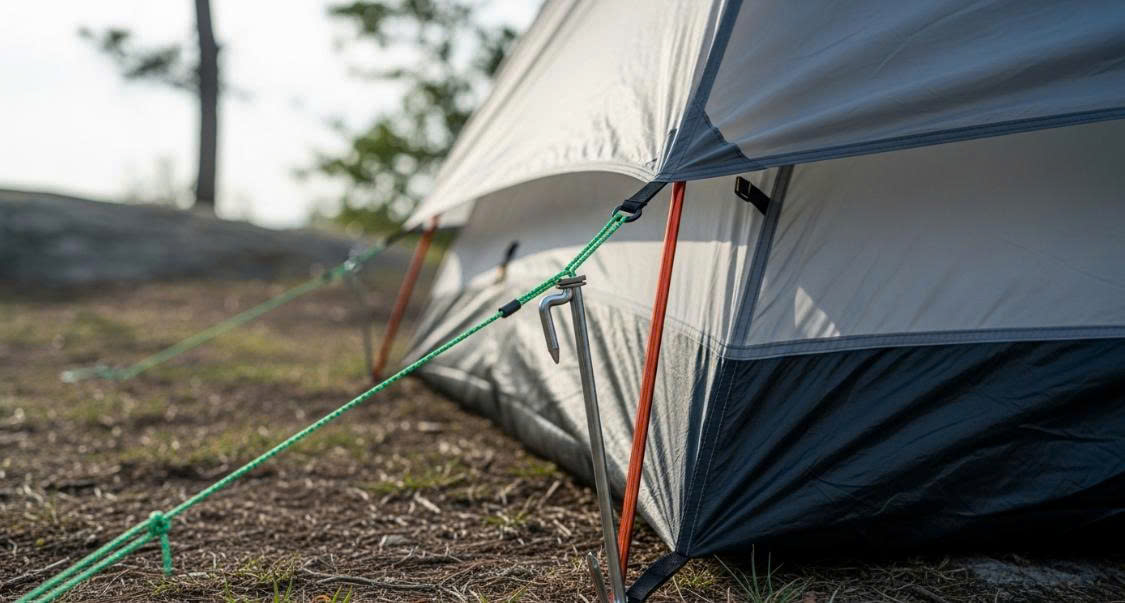The ideal golf shaft for you depends on factors like your swing speed, playing style, and personal preference. Generally, players with faster swing speeds benefit from stiffer shafts (e.g., stiff or extra stiff), while those with slower swing speeds should consider more flexible shafts (e.g., regular or senior flex) to optimize control and distance. Choosing the right golf shaft is crucial for optimizing your performance on the course. The appropriate shaft can enhance your swing, improve accuracy, and increase distance.

What is a golf shaft?
A golf shaft is the long, tapered tube that connects the clubhead to the grip, allowing the golfer to swing the club and hit the ball. It is typically made from materials like steel or graphite and comes in various flexes and weights to suit different swing speeds and playing styles.
Types of Golf Shafts
1. Material
- Graphite Shafts:Lighter and generally more flexible than steel.
- Steel Shafts:Heavier and more durable, providing better control and accuracy.
2. Flex
The flex of a golf shaft affects how much it bends during the swing, impacting distance and accuracy. Here’s a breakdown of flex types based on swing speed:
|
Flex Type |
Swing Speed (mph) |
Typical Distance |
|
Ladies |
Under 72 |
Under 180 yards |
|
Senior |
72 - 83 |
180 - 200 yards |
|
Regular |
84 - 96 |
200 - 230 yards |
|
Stiff |
97 - 104 |
230+ yards |
|
X-Stiff |
105+ |
240+ yards |
For beginners, Regular Flex is often recommended as it provides a good balance of distance and control, allowing for improved learning and consistency.
Additional Considerations
3. Swing Speed
Understanding your swing speed is crucial. You can measure this using a launch monitor or by visiting a golf shop that offers fitting services. Generally, the faster your swing speed, the stiffer the shaft you should consider.
4. Kick Point
The kick point refers to the point along the shaft where it bends the most during the swing. A lower kick point can help launch the ball higher, while a higher kick point can produce a lower ball flight. This is more of a personal preference and can be adjusted based on your playing style.
5. Length
The length of the shaft also affects performance. Standard lengths are typically around 45 inches for drivers and 37-39 inches for irons. Taller players may benefit from longer shafts, while shorter players might need shorter ones for better control.
Recommendations
- Beginners: Start with Regular Flex graphite shafts to maximize distance while learning proper swing mechanics.
- Intermediate Players: If you have a swing speed between 84 and 96 mph, consider Regular or Stiff Flex based on your comfort and control.
- Advanced Players: If you consistently swing above 97 mph, opt for Stiff or X-Stiff shafts to maintain accuracy and distance.
Ultimately, the best way to determine the right shaft for you is to test various options and consider getting fitted by a professional. This ensures that you find a shaft that complements your swing style and enhances your overall game.
What golf shaft should i use in my driver?
The best golf shaft for your driver depends on your swing speed, tempo, and personal preferences. Generally, players with faster swing speeds benefit from stiffer shafts (e.g., stiff or extra stiff), while those with slower swing speeds might prefer more flexible shafts (e.g., regular or senior flex).

Key Factors to Consider
1. Flex
The flex of a shaft affects how much it bends during your swing, which in turn influences the trajectory and distance of your shots. Here’s a general guideline based on swing speed:
|
Swing Speed (mph) |
Recommended Flex |
|
Under 75 |
Ladies or Senior |
|
75 - 95 |
Regular |
|
95 - 110 |
Stiff |
|
Over 110 |
Extra Stiff |
Choosing the correct flex is crucial; a shaft that is too flexible can lead to loss of control, while one that is too stiff can hinder distance.
2. Weight
The weight of the shaft can significantly impact your swing. Generally, lighter shafts allow for increased swing speed, while heavier shafts can provide better control. Typical shaft weights for drivers are:
- 50-60 grams: Suitable for players with slower swing speeds.
- 60-70 grams: Ideal for average swing speeds (90-105 mph).
- 70+ grams: Best for players with faster swing speeds (over 105 mph).
3. Kick Point
The kick point, or flex point, of the shaft determines the trajectory of your shots. A lower kick point typically results in a higher launch angle, while a higher kick point promotes a lower launch angle. Depending on your desired ball flight, you might prefer:
- Low Kick Point: Higher launch and more spin.
- Mid Kick Point: Balanced performance.
- High Kick Point: Lower launch and less spin.
4. Length
Driver shafts typically range from 44 to 46 inches. A longer shaft can provide more distance but may compromise control and consistency. Consider your comfort and ability to consistently hit the ball straight when selecting shaft length.
Custom Fitting
While the above guidelines can help you make an informed choice, the best way to determine the right shaft for your driver is through a custom fitting. A professional fitter can analyze your swing characteristics, recommend specific shafts, and allow you to test different options to find the perfect match for your game.
What are the best golf shafts for drivers?
Choosing the right golf shaft for your driver is crucial for optimizing performance, including distance, accuracy, and feel. Here are some of the top options for driver shafts in 2024, categorized based on their characteristics and suitability for different swing types.
Top Driver Shafts
1. Fujikura Ventus TR BlueCharacteristics
2. Graphite Design Tour ADCharacteristics
3. Mitsubishi Chemical DiamanaCharacteristics
4. Project X HZRDUS Smoke BlackCharacteristics
5. UST Mamiya Proforce V2Characteristics
6. Aldila RogueCharacteristics
7. Breakthrough Golf Technology (BGT) BravaCharacteristics
8. TPT Driver ShaftCharacteristics
Choosing the Right Shaft
- Flex: Match the shaft flex to your swing speed. Faster swings typically require stiffer shafts.
- Weight: Lighter shafts can help increase swing speed, while heavier shafts often provide better control.
- Launch and Spin Characteristics: Choose a shaft based on your desired ball flight. Low spin shafts are great for faster swing speeds, while higher launch shafts can help with distance for slower swings.
- Kick Point: The kick point affects how the shaft bends during the swing, influencing launch angle and spin.
What is a uniflex golf shaft?
A uniflex golf shaft is a type of shaft that provides a balance between flexibility and stiffness, making it suitable for a wide range of swing speeds and player types. A uniflex shaft is designed to offer a middle ground between regular and stiff flex shafts. It is made from a combination of materials, often steel and graphite, to enhance its performance. The term "uniflex" refers to its ability to adapt to different swing speeds and player styles.

Benefits of Uniflex Shafts
- Provides a balance between control and distance.
- Enhances swing speed without sacrificing control.
- Offers a responsive feel and adapts to your swing style.
- Suitable for golfers with swing speeds between 75-95 mph.
Who Should Use Uniflex Shafts?
- Beginners and golfers with inconsistent swing speeds.
- Intermediate and recreational golfers looking for a middle-of-the-road shaft.
- Golfers who fall between the regular and stiff flex categories.
Drawbacks of Uniflex Shafts
- High variability in performance.
- Steel material makes it heavier than graphite shafts.
- Not as easy to swing fast compared to regular flex shafts.
- Not recommended for slower swing speeds under 75 mph.
In summary, a uniflex golf shaft is a versatile option that can benefit golfers with swing speeds between 75-95 mph who are looking for a balance between control and distance. However, it may not be the best choice for beginners or golfers with very slow or very fast swing speeds.
What is a Tipped Golf Shaft?
A tipped golf shaft, often referred to as "shaft tipping" or "tip trimming," involves removing material from the tip end of a golf club shaft rather than the grip end. This technique is commonly employed to fine-tune the performance characteristics of the shaft, particularly in terms of stiffness, torque, and overall feel.

What is Shaft Tipping?
Shaft tipping is the process of cutting a specific length from the tip of the shaft, which alters its performance. This is distinct from the more common practice of cutting from the butt end to adjust the overall length of the club. By trimming from the tip, golfers can achieve a stiffer flex profile, which can lead to a lower launch angle and reduced spin rates during play.
This adjustment is particularly favored by more skilled players who seek to customize their equipment to better match their swing dynamics and preferences. The process is most often applied to steel iron and wedge shafts, but it can also be used with graphite shafts in woods and drivers.
Effects of Tipping
The primary effects of tipping a shaft include:
- Increased Stiffness: Trimming from the tip makes the shaft stiffer, which can lead to improved control and reduced twisting during impact.
- Altered Torque: Tipping can increase the shaft's torsional stiffness, making it less prone to twisting. This is particularly beneficial for players who generate higher swing speeds.
- Flex Profile Adjustment: The amount of material removed will affect the flex. For example, removing ½ inch may change the flex from a stiff (S) to an extra stiff (X) profile, while 1 inch can shift it further.
- Impact on Launch and Spin: Tipping generally results in a lower launch angle and less spin, which can be advantageous for players looking to achieve specific ball flight characteristics.
When to Consider Tipping
- Swing Speed Adjustments: If a player's swing speed is between two flex categories, tipping can help achieve a more suitable flex without needing to switch shafts entirely.
- Fine-Tuning Performance: Players looking to enhance control over their shots or reduce spin rates may benefit from tipping.
- Customization for Specific Clubs: Tipping is often used in the fitting process for fairway woods and drivers to optimize performance based on the player's unique swing characteristics.
In summary, tipped golf shafts allow for precise customization of a club's performance, making them a valuable tool for golfers seeking to enhance their game through tailored equipment.
What is a Pured Golf Shaft?
A pured golf shaft refers to a shaft that has undergone a specialized process known as SST Puring. This technique is designed to align the shaft in its optimal position within the clubhead, enhancing its performance by minimizing inconsistencies during the golf swing.
Understanding SST Puring
The SST Puring process involves using a machine that analyzes the structural characteristics of the shaft to identify its most stable bending plane, referred to as the Neutral Axis. This is crucial because golf shafts are not perfectly straight or round; irregularities can cause unwanted bending and twisting during the swing, leading to increased shot dispersion and inconsistent performance.
By aligning the shaft in its optimal orientation when it is attached to the clubhead, players can experience:
- Improved Consistency: Pured shafts can lead to more uniform performance across different clubs in a set, resulting in better shot accuracy.
- Enhanced Distance: Some studies suggest that using pured shafts can increase distance by 5 to 10 yards due to better energy transfer and higher clubhead speed.
- Better Feel: Golfers often report that pured shafts provide a more responsive feel, especially on mishits, leading to improved playability.
- Tighter Shot Dispersion: Puring can significantly reduce the variability in shot patterns, allowing for more predictable results on the course.
Cost and Considerations
The cost of puring a shaft typically ranges from $25 to $40 per shaft when done during the initial assembly of a club. Retrofitting an existing club can be more expensive, often exceeding $80, as it requires disassembling and reassembling the club after puring.
While many professional golfers utilize this service, the decision to pure a shaft may depend on individual preferences and performance goals. For serious golfers looking to optimize their equipment, investing in pured shafts can be a worthwhile consideration to enhance their game.
How heavy should my golf shaft be?
The ideal weight of your golf shaft depends on your swing speed and strength: slower swing speeds typically use lighter shafts (50-60 grams for drivers, 80-100 grams for irons), while faster swing speeds benefit from heavier shafts (60-80 grams for drivers, 100-130 grams for irons).

General Weight Range
Golf shafts typically range in weight from about 45 grams for ultra-light graphite shafts to over 130 grams for heavier steel shafts. The choice of weight depends on various factors, including your physical characteristics, swing speed, and personal preferences.
Factors Influencing Shaft Weight Selection
1. Swing Speed: Faster Swing Speeds
2. Swing Tempo: Players with a quick tempo may prefer heavier shafts to help maintain control, while those with a smoother tempo might opt for lighter shafts for better feel and responsiveness.
3. Balance and Control: A shaft that is too light can lead to a loss of control, resulting in inconsistent shots. If you feel disconnected from the club during your swing, it may be too light.
4. Personal Preference: Ultimately, comfort and feel are paramount. Golfers should choose a shaft weight that feels right for their swing style and allows them to perform consistently.
Recommendations Based on Club Type
- Drivers: Typically, the lightest shafts are found in drivers, usually weighing between 50-70 grams.
- Fairway Woods: These shafts generally weigh slightly more, around 60-80 grams.
- Hybrids and Irons: Iron shafts can vary from 70-100 grams, with some players opting for even heavier options based on their strength and swing dynamics.
- Wedges: Wedge shafts are often the heaviest, ranging from 90-110 grams, to provide better control for precision shots.
Finding the right shaft weight is a personal journey that often requires experimentation and potentially a fitting session with a professional. The goal is to select the lightest shaft that you can control effectively without sacrificing dispersion or accuracy. By considering your swing speed, tempo, and personal preferences, you can make an informed choice that enhances your overall performance on the course.
Are golf driver shafts interchangeable?
Golf driver shafts are generally interchangeable as long as they fit the clubhead's hosel and have the same shaft tip diameter. However, performance can vary based on shaft flex, weight, and length, so fitting and proper installation are crucial for optimal results.
Some key points about interchangeable driver shafts:
- In the last decade, several companies like Alpha Golf, Nakashima, and Versus Golf started offering driver heads with built-in adapter systems to allow for quick shaft changes.
- The major OEMs like Callaway, TaylorMade, and Ping soon followed with their own interchangeable shaft fitting systems, but each uses a unique adapter that is not cross-compatible.
- When changing shafts, the adapter on the shaft tip needs to match the hosel of the specific driver head. Trying to swap shafts between brands usually requires installing a new adapter.
- Shaft performance can vary greatly even if the flex and weight are the same. Golfers should get properly fit to find the optimal shaft for their swing.







.jpg)
.jpg)






